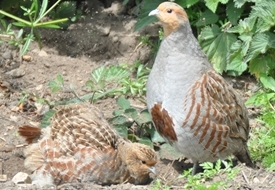 The Game & Wildlife Conservation Trust (GWCT) is launching a project to re-introduce the grey partridge to Cornwall.
The Game & Wildlife Conservation Trust (GWCT) is launching a project to re-introduce the grey partridge to Cornwall.
Our native grey partridge (Perdix perdix) flourished as humans cleared land for agriculture. But over the last 50 years, numbers of these surprisingly colourful gamebirds have crashed from millions to just over 65,000 breeding pairs. Not only have numbers decreased nationally but their range has also reduced. The Cornish Grey Partridge Project (CGPP) has been devised in response to this decline.
Research by the GWCT has shown that, with the right habitat management and a reintroduction of birds, populations can be restored. An area around Tregirls, Padstow, part of the Prideaux-Brune Estate, has been chosen for the CGPP. A great deal of work has already taken place on the estate, with the support of Charlie Watson Smyth and his family, as well as Natural England and the RSPB. Grey partridge broods, kindly provided by David Butler of Perdix Wildlife Supplies, will be introduced to the area in Autumn 2016 and the population will be carefully monitored for five years. The birds will be supported through ongoing predator control, with the aim of protecting sitting hens, nests, eggs and young chicks.
GWCT’s Director of Research, Professor Nick Sotherton, says: “This project is extremely important to our native grey partridges. Managing land for biodiversity is core to GWCT research. It is always exciting to get the opportunity to work with conservation-minded farmers to put our research into practise.”
There are some pockets of the UK where grey partridge populations can still be found, and the GWCT have published advice for landowners to help them increase numbers. GWCT research has shown that two factors are at play in the drop in numbers. Firstly, intensification of farming has reduced the numbers of insects available in our fields, meaning that young grey partridge chicks are starving to death. Secondly, these ground-nesting birds and their chicks are vulnerable to predators such as crows and foxes.
The CGPP will be officially launched at this year’s Royal Cornwall Show, Friday 10 June, 6pm at the GWCT stand – 787 RCS, show map grid reference F2. In addition, a number of people involved in the project will be at the stand during the day. They encourage visitors to join them to learn more.
For press enquiries, please contact David Thurgood, GWCT West Country Regional Organiser.
E: dthurgood@gwct.org.uk
T: 01297 678275
Notes to editors
The Game & Wildlife Conservation Trust – providing research-led conservation for a thriving countryside. The GWCT is an independent wildlife conservation charity which has carried out scientific research into Britain’s game and wildlife since the 1930s. We advise farmers and landowners on improving wildlife habitats. We employ more than 60 post-doctoral scientists and other research staff with expertise in areas such as birds, insects, mammals, farming, fish and statistics. We undertake our own research as well as projects funded by contract and grant-aid from government and private bodies.
For information, contact:
Eleanor Williams
Telephone: 07592 025476
Email: press@gwct.org.uk